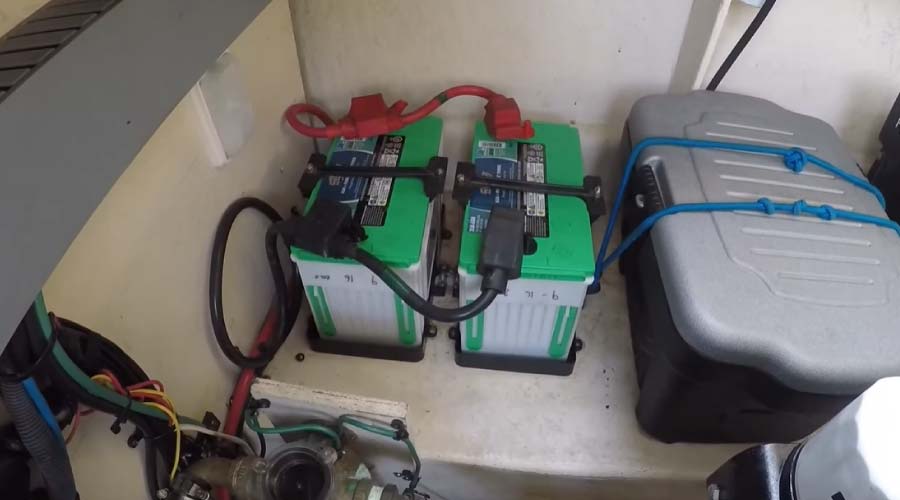How To Replace Boat Battery In 7 Steps? – Step-By-Step Guide
In this article, you will learn How To Replace Boat Battery safely with some maintenance tips to prolong the life of your batteries.
There comes a time when you’re ready to hit the open water in your boat. You are finding an escape from the world but as soon as you turn on the boat, the engine doesn’t start and your whole plan of yours becomes useless. The reason behind it is the bad battery.
If it’s your first time having a boat, then you may be wondering about how to replace a boat battery. No worries at all!
How To Replace Boat Battery
In this article, I’ll share some of the easiest ways to do this task without any difficulty. The process is quite similar to the installation of a car’s battery but in this case, you’ll need more than one battery.
Maybe this process sounds complicated initially but it’s not true. When you’ll do it for the first time, it will be easier for you to do it again whenever needed.
Tools Required For Replacing Boat Battery
These are the important tools you’re going to use during replacing the boat batteries.
Reasons For Battery Problems
Short-life batteries or dead batteries are some of the worst nightmares for boat owners. There could be many reasons for it and some of them are mentioned below:
A Step-By-Step Guide On How To Replace Boat Battery

Whatever the reason is, you’ve to fix it now to get your life on the boat again. Below is a step-by-step guide to help you replace the battery of your boat. We’ve experimented with installing many boat batteries to do this whole process in the right way. Just follow each step consciously to get the best results.
1. Purchase A New Boat Battery:
It’s obvious that to install new batteries, you’re going to need a new battery. So, buy a brand-new battery with good qualities such as longevity, durability, and reliability. You’ll need only a high-quality battery because it has to survive in marine facing extreme vibrations, regular shifting, and constant wave pressure pounding against the boat. That’s why it has to be more powerful with high draining ability.
If somehow you ignore the quality, you’ll definitely need to buy a new one once again sooner or later. While buying a boat battery, make sure you’re purchasing the right one. Do not buy a battery for a car to use for the same purpose in the boat.
2. Open The Battery Compartment:
The first step in replacing the boat battery is to open the battery compartment and examine it properly to find out all the issues. Check both terminals to get to know about any acid leakage. If you find any leaks, clean them immediately.
To clean off dirt or any other material, use a wire brush gently over the place. For cleaning cable terminals, use only anti-corrosion grease.
3. Disconnect Negative And Positive Cable Terminals:
Disengage the negative terminal first with the help of a socket wrench or pliers. It will be helpful to get rid of stubborn wingnuts. Be careful while doing this, if the nuts are over-tightened.
After removing the negative terminal (black cable), remove the positive terminal (red cable). Try to avoid any connection between positive and negative cables.
Do not even touch any terminal or cable with bare hands if you don’t want to sustain any shock.
4. Remove The Old Defective Battery:
Remove the old battery and place it aside carefully. Clean the terminals with great care because now is the right time to do it. To remove corrosion or any oxidation, use a wire brush gently over it. Then apply some protective or conductive grease to complete this step.
5. Put The New Battery In Its Place:
Leave the compartment intact for some time to let it dry fully. After drying it out, place the new batteries in that specific compartment. Fix the battery appropriately its place. If you make loose connections, that can endanger your life as well as of boat during times of use.
6. Reattach The Positive And Negative Cable Terminals:
Detaching and reattaching the positive and negative cable terminals are two different steps and you have to be very careful while doing so.
First, reattach the positive cable terminal (the red one) to the top positive terminal post of the battery. Re-thread, and make sure not to over-tighten any nut.
Again, be careful and avoid getting in touch with bare hands on any of the terminals.
Attach the negative cable to the negative terminal of the battery and again follow all precautionary measures while doing this. Finish the re-threading of nuts just like you did for the positive terminal.
7. Put The Covers And Straps Back In Their Place:
As you’ve done the main part of this job, now replace the covers and straps back to secure the battery inside its compartment. You need to fix it tightly because boats tend to move in jerky motions while running on the surface of the water.
Clean the compartment, put the key inside, and take your boat for a test run.
Checkout ur guide about how to charge golf cart batteries.
How To Install Multiple Batteries In The Boat?
As I’ve already mentioned, a boat runs on more than one battery, and sometimes you may need to go for multiple batteries installation. It may sound complex to you, but it is just like the above process.
Before installing batteries, make sure to select a similar type and a group of batteries. After purchasing the second, strap it to the battery box beside the primary one.
Follow the steps I’m mentioning below to understand how to install multiple batteries in your boat.
How To Do Parallel Installation?
In this case, two batteries are made to connect from positive to positive and negative to negative. Connect the neutral port of the primary battery to the neutral terminal of the secondary battery. While the positive port of the first should be connected to the positive port of the secondary battery.
This will ensure a longer life, more capacity, and amp-hour rating for your batteries.
How To Replace Boat Battery – What Is Series Installation?
In the series installation, the positive port is connected to the negative. This goes the same with the other ports. If you have more batteries, you can make the same kind of connections. This will help to increase the voltage and keep the battery steady but won’t help in enhancing the life of the battery.
Do You Need To Change All Boat Batteries At Once?
You will only need to change all batteries if they are within the same isolated bank and they’re connected to each other in series or parallel. It will help to preserve the longevity and integrity of the battery.
It is better to buy all new batteries and get an extra 5 to replace whenever a battery dies so you’ll replace it without any worry.
When Do We Need To Change All Batteries?
If the battery is isolated from other batteries and also has its own bank, then you’ll need to change only a single battery at a time. In most small and mid-sized boats, it is common to have a started battery to start the engine and other batteries, you can call a house battery to power everything else.
There’s a possibility that if one battery dies, the other will also start to lose its strength over time. But it can be reversed such as your starter battery dies but the house battery lasts for up to 3 more years.
How Often To Change A Boat Battery?
The longevity of a boat battery depends on the frequency of use, climate, maintenance, depth of discharges put on them, and the charging habits of the user.
But as for good expectation, you can reasonably expect to change a boat battery after 5 to 6 years.
This can only be expected if you use your boat only on weekends for almost 4 months a year, and you always keep it charged with the help of a smart charger even when not in use and keep on checking the level of the electrolyte.
Maintenance And Safety Tips
Here are the following essential tips you should always consider while replacing a boat battery:
Can You Prolong The Lifespan Of Your Battery?
We can’t do much about the battery costs, but we can do some things to prolong the battery life of a boat and save the costs of replacement.
Hope we have cleared your concepts about how to replace boat batteries, Now you can change them without spending extra cost.
FAQs – Frequently Asked Questions
Can you recharge a dead boat battery?
Deep cycle batteries are the only unique power source for marine applications. They’re designed to be discharged to no power at all and then you can charge them again to the new state.
What is the difference between a marine battery and a deep-cycle battery?
A marine or cranking battery allows the boat to start and get out on the water. While the deep cycle marine battery keeps the boat operating by running electronics in any situation.

Josh is a highly skilled electrician with specialized expertise in the field of generators. With years of experience under his belt, he has established himself as an expert in all aspects of generators, ranging from installation and maintenance to troubleshooting and repairs. Josh’s in-depth knowledge of electrical systems and his commitment to staying updated with the latest industry advancements make him a reliable and sought-after professional.
